Similar to Ed Piskor’s Hip Hop Family Tree, French writers Thierry Lamy and Nicolas Finet detail the origins of punk rock with their graphic novel, Punk Rock in Comics from NBM Graphic Novels. Told in eight-page chunks, these bite-sized chapters detail a certain aspect of the scene, band, or figure important to punk rock from the genre’s roots in the mid-seventies to the early 1980s, each drawn by a different artist. Mixing comics with essays and photos peppered throughout give the comic the feeling that you’re reading a zine covering the early punk rock scenes on both sides of the Atlantic. We caught up with Thierry Lamy and Nicolas Finet to speak about their graphic novel.
Dying Scene (Forrest Gaddis): A lot of our readers are probably not too familiar with your work. Can you give us some background information about yourself?
Thierry Lamy: I have been a comic book writer for a little more than 20 years. Although my works are diversified, I mainly specialize in historical stories (Labiénus, Combattants du Rail, El Alamein). My latest comics are about rock music (David Bowie, AC/DC, Pink Floyd, Led Zeppelin, Punk!), with some forays into fantasy westerns (Hell West, Promise), science fiction (Skraeling), and the adaptation of novels and tales (Le Père Goriot, Nerrivik, Contes celtes, Contes Yiddish, and Contes Inuit). Like all comics authors, it is the passion that drives me, both for the comics medium and the subjects I explore.
Nicolas Finet: I’m a former journalist who became a publisher and writer about twenty-five years ago. I’ve written more than twenty different books, mainly about comic book artists, the comic book industry, Asia (another passion, related to my former life as a reporter), and music. In 2008, I was the publisher and one of the contributing writers of a manga dictionary (DicoManga – Le Dictionnaire encyclopédique de la bande dessinée japonaise), which remains the only French-language dictionary ever published about Japanese manga. I also directed two documentary films, one about the late manga artist Jiro Taniguchi (along with Nicolas Albert) and, more recently, another in 2018 about two French comic book artists following the tracks of bluesman Robert Johnson in Mississippi. It’s called Mississippi Ramblin’.
Dying Scene: Were either of you active in the punk rock scene in France?
Thierry Lamy: Active, no. I’m from the generation of post-punk and French alternative rock. I discovered and loved the founding groups of punk in the early 1980s. However, the punk movement was still alive enough at that time to have a profound impact on my younger years. My interest in punk has never left me.
Nicolas Finet: I would not qualify my role as “active,” but I did play guitar for a while in a band with some friends at the very end of the 1970s. Nothing serious, and I’m afraid I was not a very good musician, but I still love playing for myself, here and there. I was born in 1959 and was a teenager when the whole punk scene started in Great Britain in 1975 and 1976. Like many people my age at the time, I was very close to what was happening in the music scene. We had very good musical magazines in France, so it was quite easy to follow what was happening. Punks were among the most exciting things to see and listen to then. We were there when the Sex Pistols and the Damned and all these bands started, can you imagine? It was definitely fantastic—and so new for everyone!
Dying Scene: I can see from the NBM graphic novels website you have both done other comic biographies. Where did the idea for those projects come from? How did you land on punk rock as your next project?
Thierry Lamy: Nicolas is the one who initiated these projects. I’d like to add that he gave me a great gift by offering to let me write them, since I’m passionate about rock music. Among all the titles we have done for this series, “Punk Rock in Comics” is my favorite.
Nicolas Finet: Almost everything that I’ve been involved with, related to the different musical projects published by NBM, comes from my life experience. From the very beginning, I have been passionate about music. I’m a French rock’n’roll kid. I also have a deep love for comics. Comic books were very big in France in the 1970’s thanks to magazines like Heavy Metal. It sounded obvious to me to merge those two influences. It did not happen immediately, but with time, and thanks to the publishing companies who gave me this opportunity, I had the opportunity to express my experience of both music and comics by starting with the books published by NBM. I started with David Bowie, one of my favorites, and wrote the comic, Starman. I then followed with titles focusing on Prince, AC/DC, and Pink Floyd, and more recently, Led Zeppelin and punk. I also wrote a comic book about Woodstock and another about Janis Joplin, both illustrated by my good friend Christopher, who is also a regular contributing artist on books released by NBM. The link between all these projects is my own life. As a teenager, I always felt impressed by Bowie and Pink Floyd. I was thirteen years old when Ziggy Stardust was released and fourteen when The Dark Side of the Moon was released. Two or three years later, the punks arrived and started to shake things up! It was fun! With this punk project, I was given the opportunity to write about my own life and experiences. Who would refuse that? All writers will confirm that their favorite subject is themselves.
Dying Scene: How did you determine what bands to include? How did you determine the early 1980’s was the cut off?
Nicolas Finet: From the very beginning, I decided to cover the punk rock story from a strictly historical point of view, starting at the end of the 1960s and beginning of the 1970s in the United States with bands like The Stooges, MC5, and The New York Dolls. Then, I crossed the ocean to the pub rock scene in England around 1974, and the explosion in 1975 or 1976 with the bands I mentioned earlier—the Sex Pistols, The Damned, The Clash, etc. After that, the rest of punk lasted five years, after which the music became something else—still interesting, but different: New Wave, Dark Wave, Post-Punk, or whatever you call it. My timeframe was 1975 to 1980, and that’s it. Of course, it’s absolutely subjective, and you may have another point of view—which I consider totally acceptable. Regarding the bands included in the book, it was quite obvious: I had 20 chapters available. This is the regular format of music comic books, based on one chapter per group or artist, and selecting the bands or artists to include seemed rather simple to me.
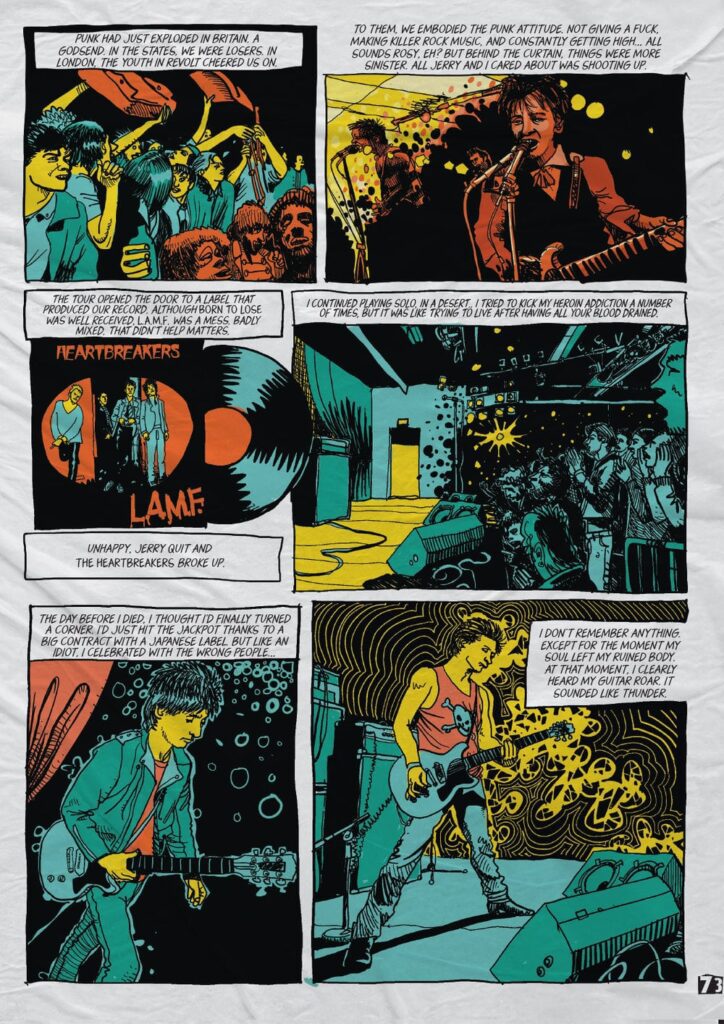
Dying Scene: Did you have a particular style in mind for each band’s section or did you leave it up to the artist? How did you decide on an artist for each chapter?
Nicolas Finet: No, I did not have any special style in mind for each chapter. The fact is that I was already used to working with many of the artists involved in the book. From the first anthology book I worked on, with David Bowie, we have had a kind of informal team. We are used to working with each other. The artists are not all exactly the same from one book to another, but the foundation relies on individuals I am confident with: Toru Terada, Christopher, Gilles Pascal, Kongkee, Will Argunas, and of course, Thierry Lamy for the scripts. When I am starting a new project, I have an idea about who will be able to draw what, and generally, when I express my proposals to the artists, they sound relevant. It also happens that some artists request to draw a musician or a group. In this book, for example, Christopher immediately decided that he would draw The Jam! What could I say except, “Yes”?
Dying Scene: I like how the pub rock chapter is included. I feel when Americans write about punk they mostly leave it out or only talk about the 101ers because of Joe Strummer. Does it get referenced more in Europe in regards to its influence on the scene out there?
Thierry Lamy: This aspect of punk history seems unknown to the general public in France, too. We always remember the Sex Pistols, the Clash, the Ramones, and a few other iconic groups or personalities. Yet, many constituent elements of punk fall by the wayside in the collective unconscious. This is true of pub rock, but also of groups like the Vibrators, Sham 69, the Saints, Stiff Little Fingers, the Slits, and many others. Our comic, therefore, hopes to do justice to all the forgotten figures of the punk movement.
Nicolas Finet: I was personally attached to the pub rock bands because, again, it is linked to my personal memories of that period. When it started in the mid-1970s, I was in high school. Bands such as Dr. Feelgood or Eddie and the Hot Rods seemed as important as the Pistols, or sometimes more so. But at that time, no one could predict which band would endure and which would not. Even if, in the end, it became obvious that the Clash had become an international phenomenon and that Eddie and the Hot Rods, whose first two albums I loved, had not.
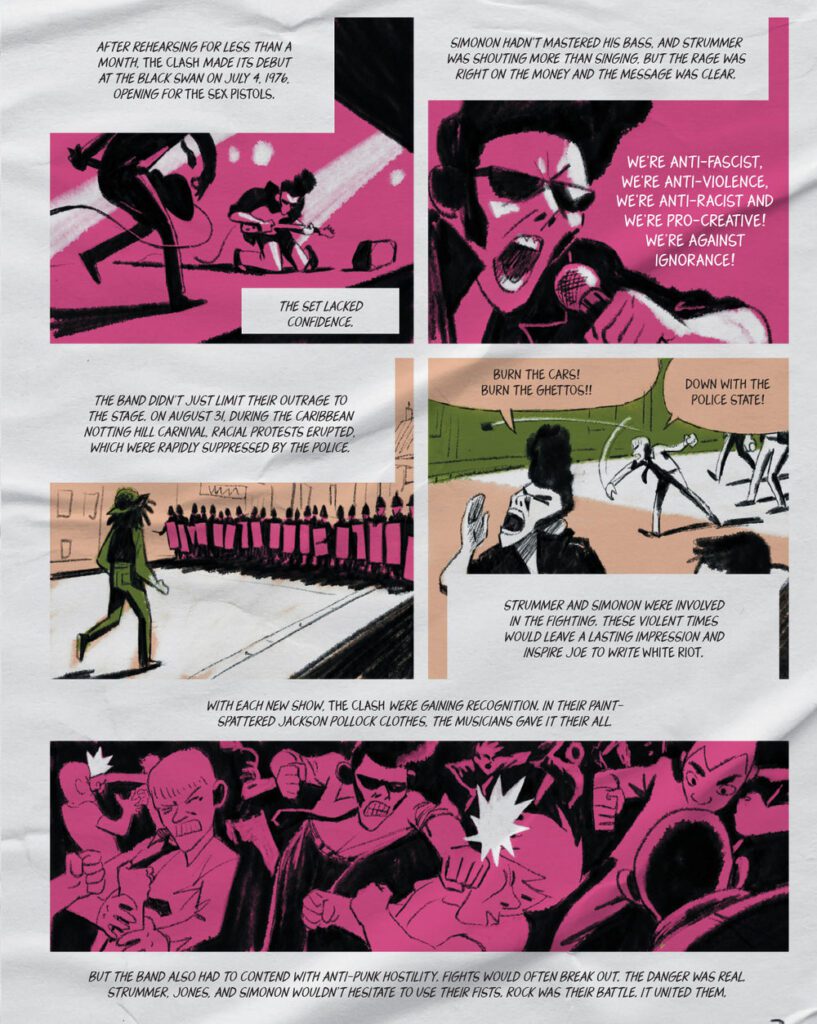
Dying Scene: More a comment than a question. I appreciated the Irish Punk chapter focusing on the Undertones and Stiff Little Fingers rather than the Pogues.
Thierry Lamy: Despite their talent and punk spirit, focusing on the Pogues in the chapter devoted to Irish punk would have been off-topic here, since they were formed in 1982. However, Shane MacGowan is not absent from “Punk Rock in Comics.” He makes a cameo in the chapter devoted to the Jam.
Nicolas Finet: It’s not a matter of loving them or not, but they are outside the scope.
Dying Scene: What made you decide to add the Lemmy Kilmeister and Don Letts chapters rather than a couple other bands?
Nicolas Finet: All musical styles influence and are influenced by other artists. This is how music works. Regarding Lemmy and Motörhead, it was more a matter of energy. The punk energy is fundamental in Motörhead’s music. There’s a question of lifestyle, too. The same observation can be made regarding the Jamaican influence on punk rock. Caribbean communities were numerous at that time in Great Britain and still are, as far as I know. The influence of their musical style on other musicians was important, including punk musicians. They were often living in the same neighborhoods. So, it seemed obvious to me to integrate these sections into the book.
Dying Scene: I liked the essays at the end of each chapter and how they sum up each section. It gives the book a bit of a zine feel to it. Where did you get the Idea to include photos in these sections?
Nicolas Finet: We like these essays, too! Basically, the principle of including an essay for each chapter was established by the French publishing company that started this collection. Being a former journalist, it reminds me of the way I used to work for the press, mixing texts and photos. It gives the reader a wider view of the story being told. This allows each chapter to cover the full story without repeating the same information in the essay and in the comic section.
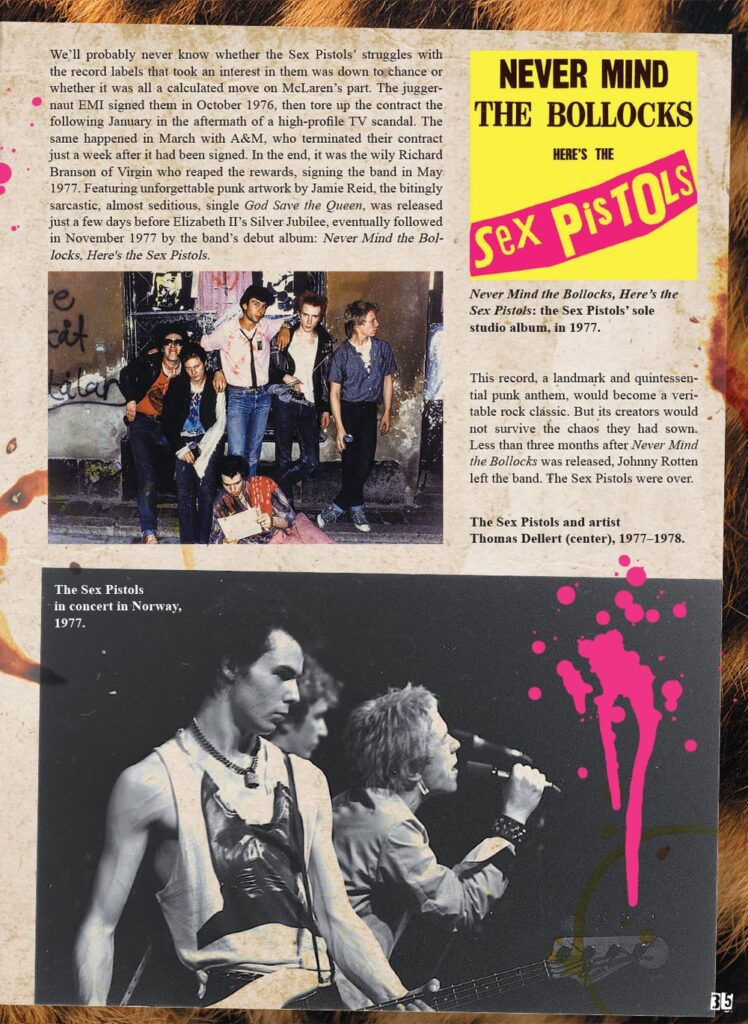
Dying Scene: Is the further reading section in the back of the book where you sourced most of the information in the book? Likewise, are the albums listed in the back your recommendations?
Nicolas Finet: The suggested reading section at the end of the book is a way to expand on the information discussed. Our work on punk rock music was based on extensive research, and the books cited at the back of the book were used as sources, among others. My personal memories and the albums listed at the back were also helpful. I have kept all my original vinyl records from this period in good condition and still listen to them regularly. There’s a lot of info in the liner notes. I consider the discography at the end of the book a basic music library for exploring punk music and its universe, but it’s only a start.
Dying Scene: Were there any bands you cut out? Was the band from elsewhere chapter a way to show those bands some love? its very random, but love that you included Beururier Noir and Ludwig Von 88.
Thierry Lamy: In the American version, the final chapter devoted to French punk is missing. We discuss alternative rock at greater length. Due to space constraints, we could not include all international punk groups, but we aimed for comprehensiveness.
Nicolas Finet: I don’t really feel that I cut any major bands of this period. We could have easily doubled or tripled the number of bands and artists we introduced in this comic. In that case, we would have needed hundreds of additional pages. When you work as a publisher, you have to deal with constraints, and the most important one, for me, was that I had only twenty-eight-page chapters available. This is why I gathered “Bands From Elsewhere” into a single chapter. It’s a way to remind readers that these bands were important to us, without using much space. As Thierry mentions, we have an additional chapter about French punk rock music in the original version of the book, but for cultural, historical, and technical reasons, this chapter is not included in the U.S. version. These bands are not well known in English-speaking countries, and French punk rock mainly starts at the beginning of the 1980s, which makes it out of scope.
Dying Scene: Are there plans to do another part of going into more punk rock history if this does well?
Thierry Lamy: Not that I know of; I’m not sure that this would be a good idea, “Punk Rock in Comics” is already quite complete. However, a comic book on the Riot Grrrl movement would be welcome, this feminist post-punk movement deserves to be better known to the general public.
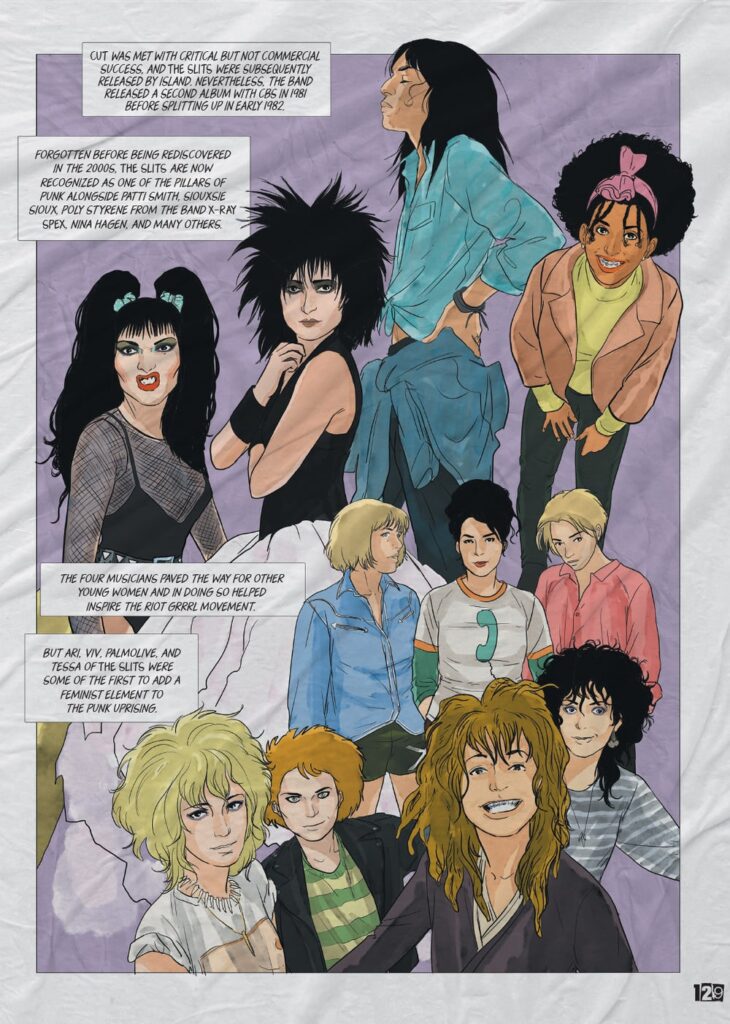
Dying Scene: Are either of you working on anything else at this time?
Thierry Lamy: I have two projects coming out soon: the first on a nineteenth-century polar expedition that ended tragically, and another on the Gulf War.
Nicolas Finet: Yes. I am now starting to write a musical biography in comics, with my old accomplice, Christopher, focusing on Syd Barrett and Pink Floyd. It will be both documentary and fictional, with Syd Barrett at the center of the story. Let’s say a fictional non-fiction, or a non-fictional fiction… We are just starting the project, so I am unable to say when it will be released. However, Christopher is a very fast artist.
Dying Scene: Anything else you want to fill Dying Scene readers in on?
Thierry Lamy: I would like to emphasize that “Punk Rock in Comics” was made with passion, like the other titles in the collection. I hope the energy we put into this comic will touch our readers, whether French or American.
Nicolas Finet: I used to say that being able to write about my teenage passions and being paid for it is an unbelievable gift. I feel fulfilled.
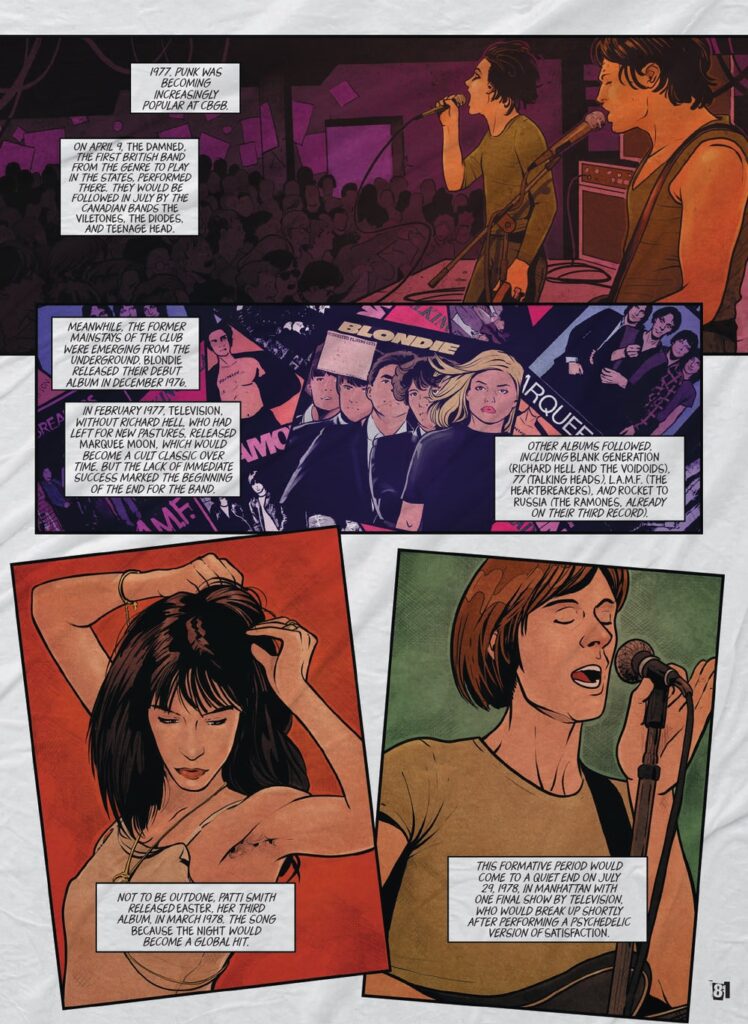
Dying Scene: This book really is a special thing. I love anthologies, but most of them are horror books. This was a nice change of pace. Are any of your other books translated in English?
Thierry Lamy: Thank you for your enthusiasm. To my knowledge, only the works in the rock book collections from NBM have been translated into English.
Nicolas Finet: If you want to find my fictional work, I know that my comic book about Janis Joplin has also been translated by NBM. It’s a graphic biography, which was also translated into Spanish and Polish. I wrote it with Christopher. It was published in France in 2000, for the 50th anniversary of her death. A year earlier, I also had another music comic book published, about Woodstock (Forever Woodstock), also with Christopher drawing. Same technique, mixing “real” history and fiction, but it has been published only in France; no translation yet. You can visit my blog, where you will find an extensive biography in English.
A big thank you to Thierry and Nicolas for their time. You can pick up Punk Rock in Comics through NBM Graphic Novels.






